Abstract
Mean serum levels of polychlorinated biphenyls (PCBs) in U.S. population groups without occupational exposure to PCBs are usually between 4 and 8 ng/mL, with 95% of individuals having serum PCB measurements of less than 20. Subpopulations consuming fish taken from contaminated waters, such as Lake Michigan and near Triana, AL, have mean serum PCB levels several times those found in other general population groups and ranges that extend into concentrations found in industrial populations involved in capacitor manufacture. Two studies of general populations and several studies of industrial workers have demonstrated associations of PCBs with various serum lipids and liver enzyme levels. Six groups of investigators have found associations between PCB or chlorinated pesticide levels and blood pressure. Research efforts are needed in clarifying determinants of serum-adipose partition ratios; the utility of urinary porphyrins as a measure of subclinical hepatic effects; human metabolites and excretion of chlorinated hydrocarbons; and the relation, if any, between blood pressure and organochlorine compounds when controlled for confounding variables. Established cohorts, such as those in Triana, Lake Michigan sportsfishers, the Michigan PBB cohort, residents of farms with PCB-lined silos, and occupational groups, could all be studied further with attention to these research questions.
Full text
PDF
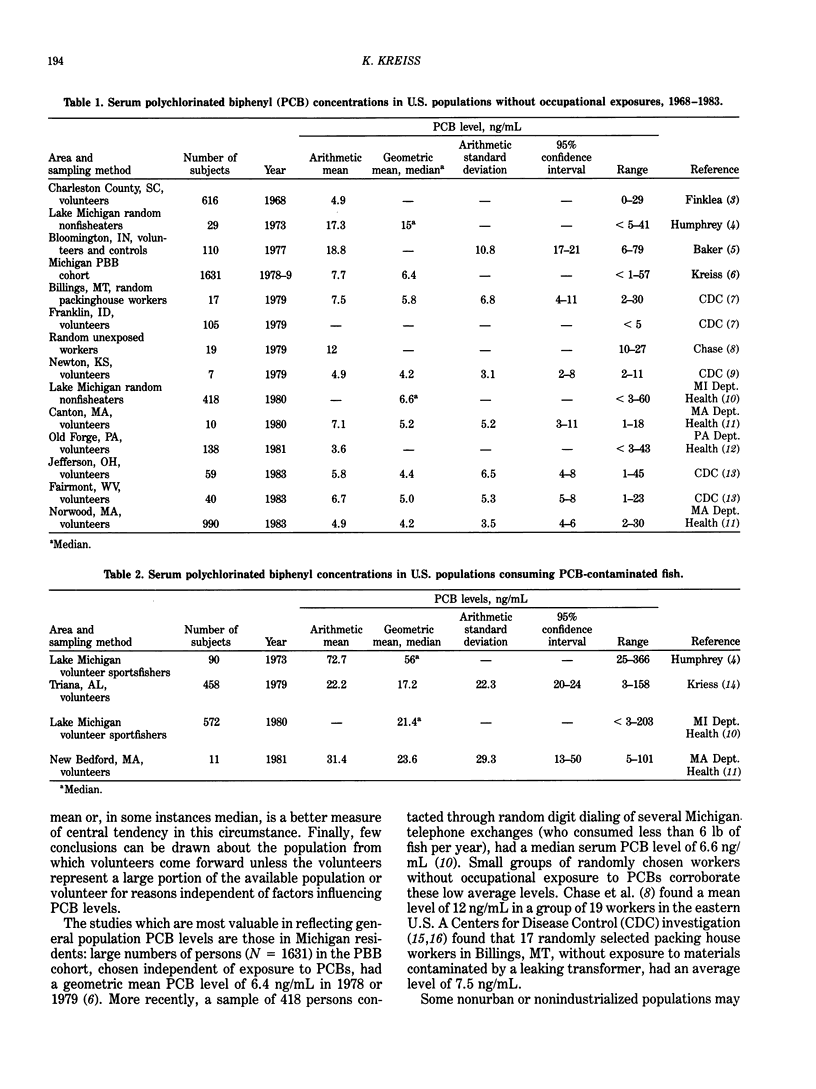
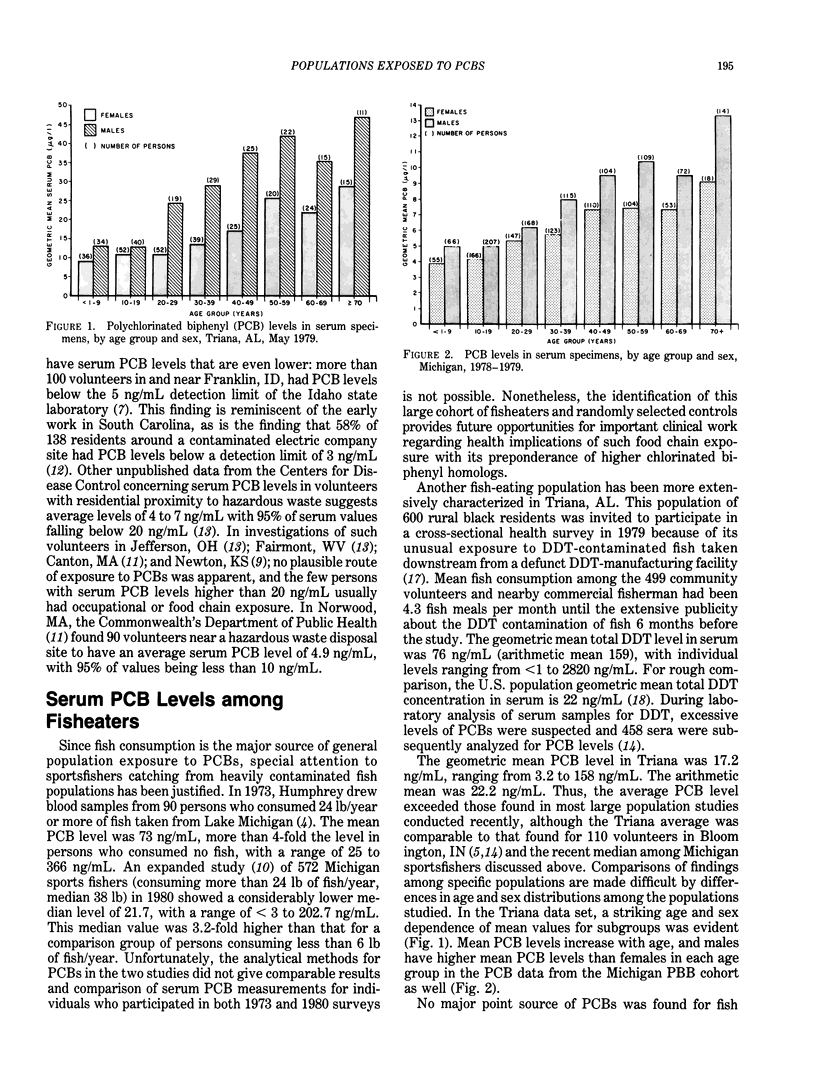
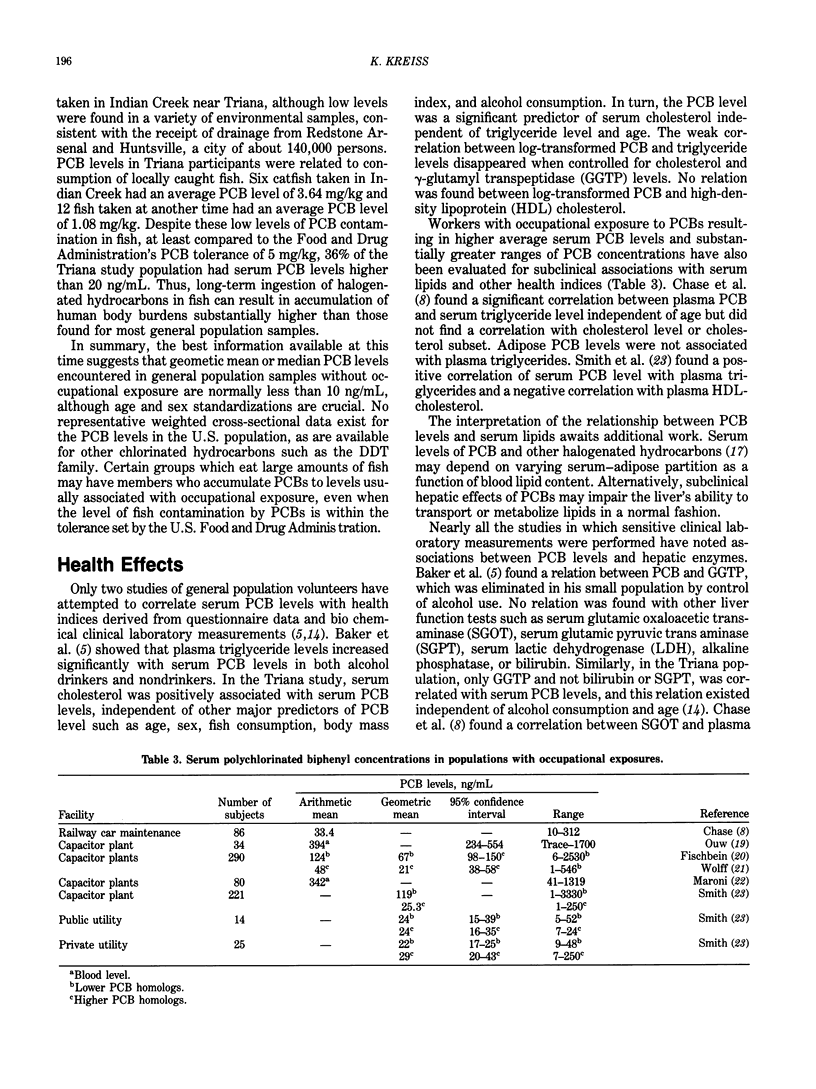
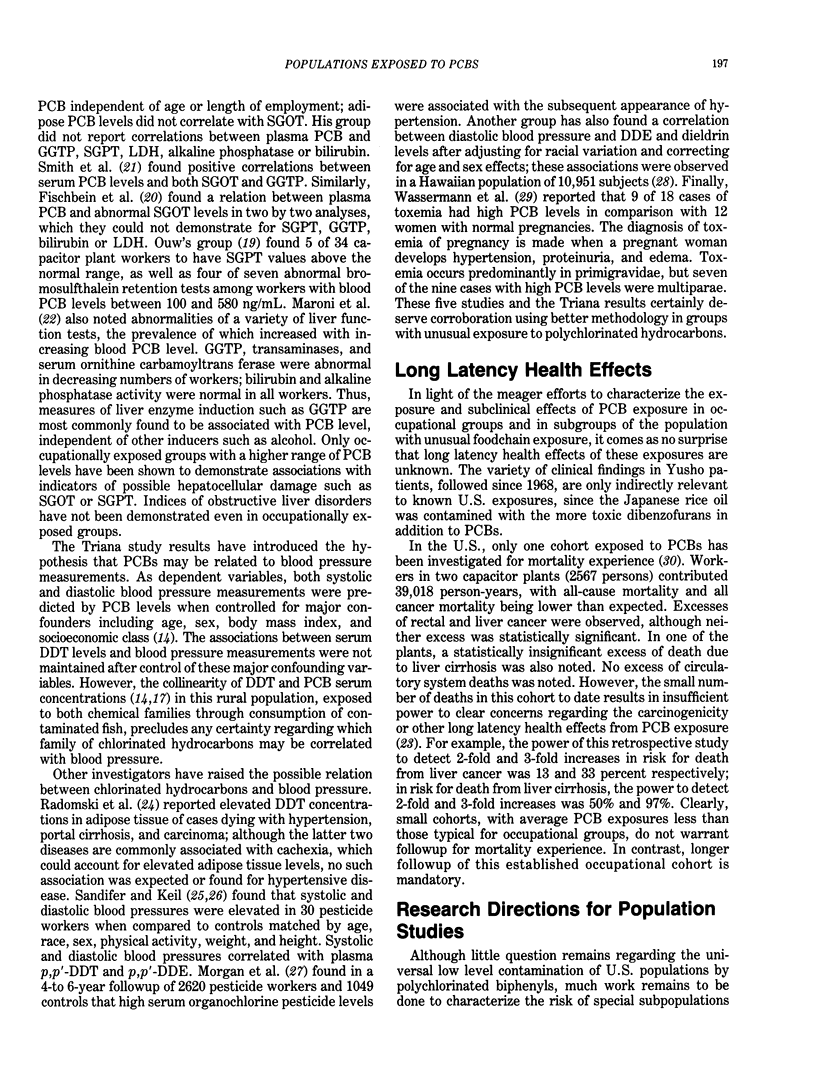
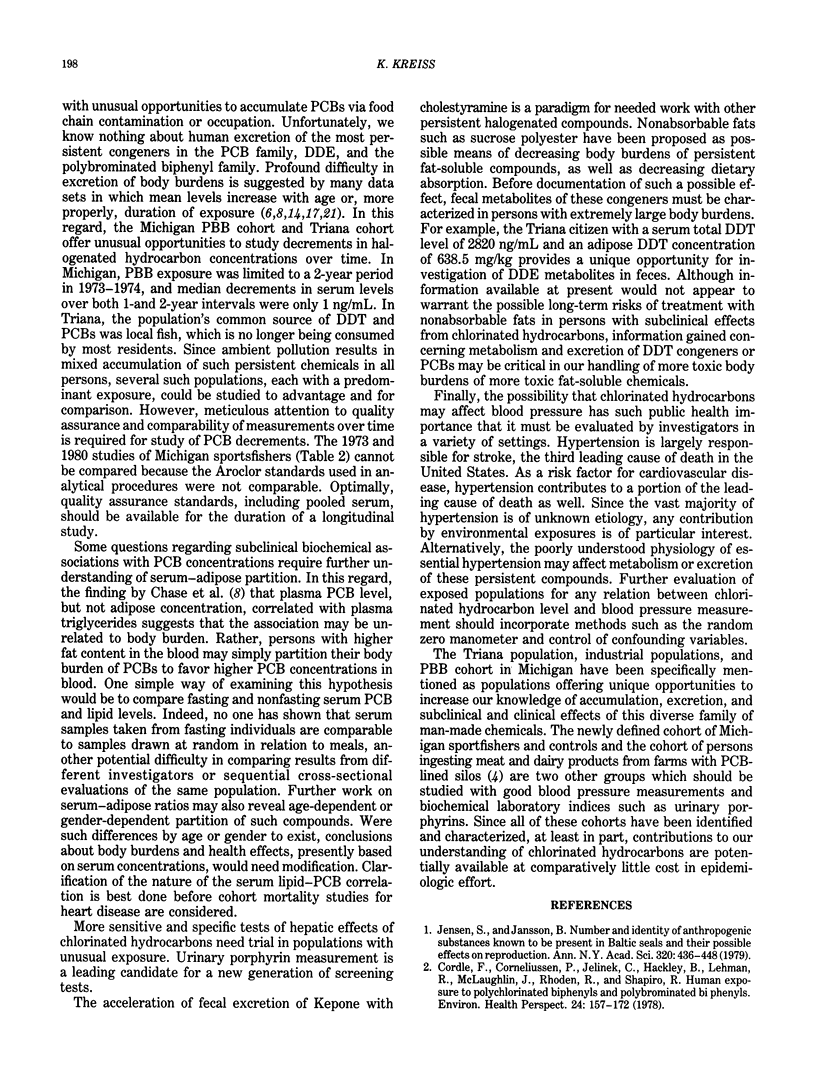

Selected References
These references are in PubMed. This may not be the complete list of references from this article.
- Baker E. L., Jr, Landrigan P. J., Glueck C. J., Zack M. M., Jr, Liddle J. A., Burse V. W., Housworth W. J., Needham L. L. Metabolic consequences of exposure to polychlorinated biphenyls (PCB) in sewage sludge. Am J Epidemiol. 1980 Oct;112(4):553–563. doi: 10.1093/oxfordjournals.aje.a113024. [DOI] [PubMed] [Google Scholar]
- Brown D. P., Jones M. Mortality and industrial hygiene study of workers exposed to polychlorinated biphenyls. Arch Environ Health. 1981 May-Jun;36(3):120–129. doi: 10.1080/00039896.1981.10667615. [DOI] [PubMed] [Google Scholar]
- Chase K. H., Wong O., Thomas D., Berney B. W., Simon R. K. Clinical and metabolic abnormalities associated with occupational exposure to polychlorinated biphenyls (PCBs). J Occup Med. 1982 Feb;24(2):109–114. [PubMed] [Google Scholar]
- Cordle F., Corneliussen P., Jelinek C., Hackley B., Lehman R., McLaughlin J., Rhoden R., Shapiro R. Human exposure to polychorinated biphenyls and polybrominated biphenyls. Environ Health Perspect. 1978 Jun;24:157–172. doi: 10.1289/ehp.7824157. [DOI] [PMC free article] [PubMed] [Google Scholar]
- Finklea J., Priester L. E., Creason J. P., Hauser T., Hinners T., Hammer D. I. Polychlorinated biphenyl residues in human plasma expose a major urban pollution problem. Am J Public Health. 1972 May;62(5):645–651. doi: 10.2105/ajph.62.5.645. [DOI] [PMC free article] [PubMed] [Google Scholar]
- Fischbein A., Wolff M. S., Lilis R., Thornton J., Selikoff I. J. Clinical findings among PCB-exposed capacitor manufacturing workers. Ann N Y Acad Sci. 1979 May 31;320:703–715. doi: 10.1111/j.1749-6632.1979.tb56645.x. [DOI] [PubMed] [Google Scholar]
- Jensen S., Jansson B., Olsson M. Number and identity of anthropogenic substances known to be present in Baltic seals and their possible effects on reproduction. Ann N Y Acad Sci. 1979 May 31;320:436–448. doi: 10.1111/j.1749-6632.1979.tb56625.x. [DOI] [PubMed] [Google Scholar]
- Kreiss K., Roberts C., Humphrey H. E. Serial PBB levels, PCB levels, and clinical chemistries in Michigan's PBB cohort. Arch Environ Health. 1982 May-Jun;37(3):141–147. doi: 10.1080/00039896.1982.10667553. [DOI] [PubMed] [Google Scholar]
- Kreiss K., Zack M. M., Kimbrough R. D., Needham L. L., Smrek A. L., Jones B. T. Association of blood pressure and polychlorinated biphenyl levels. JAMA. 1981 Jun 26;245(24):2505–2509. [PubMed] [Google Scholar]
- Kreiss K., Zack M. M., Kimbrough R. D., Needham L. L., Smrek A. L., Jones B. T. Cross-sectional study of a community with exceptional exposure to DDT. JAMA. 1981 May 15;245(19):1926–1930. [PubMed] [Google Scholar]
- Maroni M., Colombi A., Arbosti G., Cantoni S., Foa V. Occupational exposure to polychlorinated biphenyls in electrical workers. II. Health effects. Br J Ind Med. 1981 Feb;38(1):55–60. doi: 10.1136/oem.38.1.55. [DOI] [PMC free article] [PubMed] [Google Scholar]
- Morgan D. P., Lin L. I., Saikaly H. H. Morbidity and mortality in workers occupationally exposed to pesticides. Arch Environ Contam Toxicol. 1980;9(3):349–382. doi: 10.1007/BF01057414. [DOI] [PubMed] [Google Scholar]
- Ouw H. K., Simpson G. R., Siyali D. S. Use and health effects of Aroclor 1242, a polychlorinated biphenyl, in an electrical industry. Arch Environ Health. 1976 Jul-Aug;31(4):189–194. doi: 10.1080/00039896.1976.10667218. [DOI] [PubMed] [Google Scholar]
- Radomski J. L., Deichmann W. B., Clizer E. E. Pesticide concentrations in the liver, brain and adipose tissue of terminal hospital patients. Food Cosmet Toxicol. 1968 Aug;6(2):209–220. doi: 10.1016/0015-6264(68)90202-2. [DOI] [PubMed] [Google Scholar]
- Sandifer S. H., Keil J. E., Finklea J. F., Gadsden R. H. Pesticide effects on occupationally exposed workers: a summary of four years observation of industry and farm volunteers in South Carolina. IMS Ind Med Surg. 1972 May;41(5):9–12. [PubMed] [Google Scholar]
- Smith A. B., Schloemer J., Lowry L. K., Smallwood A. W., Ligo R. N., Tanaka S., Stringer W., Jones M., Hervin R., Glueck C. J. Metabolic and health consequences of occupational exposure to polychlorinated biphenyls. Br J Ind Med. 1982 Nov;39(4):361–369. doi: 10.1136/oem.39.4.361. [DOI] [PMC free article] [PubMed] [Google Scholar]
- Wassermann M., Bercovici B., Cucos S., Wassermann D., Ron M. Storage of some organochlorine compounds in toxemia of pregnancy. Environ Res. 1980 Aug;22(2):404–411. doi: 10.1016/0013-9351(80)90152-8. [DOI] [PubMed] [Google Scholar]
- Wolff M. S., Fischbein A., Thornton J., Rice C., Lilis R., Selikoff I. J. Body burden of polychlorinated biphenyls among persons employed in capacitor manufacturing. Int Arch Occup Environ Health. 1982 Feb;49(3-4):199–208. doi: 10.1007/BF00377929. [DOI] [PubMed] [Google Scholar]


